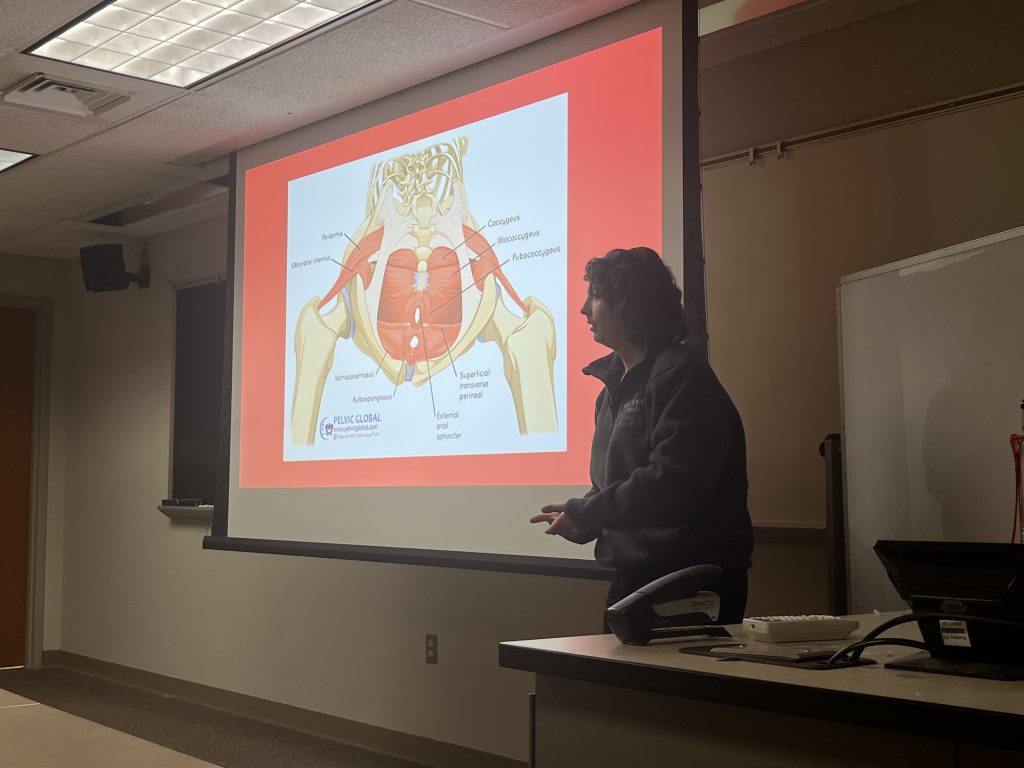Throughout the year, Bradley’s Health Science Organization (HSO) has had multiple guest speakers to educate their members about different elements of the health field.
This week, HSO hosted Assistant Professor of Physical Therapy Patricia Starkey to lecture on pelvic floor physical therapy and women’s health.
Starkey earned her Bachelor’s in Kinesiology and Health from Iowa State University and her Doctorate of Physical Therapy here at Bradley. She was asked by HSO to speak because of one student’s personal interest.
“I personally invited her because this is something that I am interested about and something that I’ve always wanted to learn more about,” Marissa Perez, junior kinesiology major and HSO president said. “And I thought that since we had the platform for it I could invite her and just see who shows up but I knew that I would be the most excited about it.”
Starkey began by describing how she got into pelvic floor therapy, a specialty practice that she still works part-time.
“I was always into pelvic floor a little bit in school because I feel like this is a more female problem than a male problem, so therefore it tends to be a little under researched and underrepresented in research,” Starkey said.
Starkey began her time at Bradley during COVID and taught as an adjunct professor for the motion analysis course. Last year was her first official year working full time on the Hilltop.
When she first started teaching, the Peoria Fire Department came to the Athletics Department asking for a way to get their members healthier, but they were referred to the Physical Therapy (PT) Department. The fire department had seen a lot of older firemen getting injured and younger firemen getting overworked.
“Now, the PT program has this project where you are in your second year of the PT program [and] you go down to the fire academy,” Starkey said. “[You] get to see what some of the firemen are doing during their job … and then the next semester they [the students] [that] are in the PT program they are making eight week fitness programs for the firemen.”
After her introduction, Starkey dove into what the pelvic floor is, noting that lots of times people forget what it is and what it does.
“It [the pelvic floor] is kind of the forgotten core muscle, it’s also like the core of the core,” Starkey said.
In the female body, the pelvis is wider, which means that there is a higher risk for pelvic floor issues in women early in life compared to men. Starkey told students to start working out now to strengthen their pelvic floor so they can avoid issues in the future.
Starkey told those attending that the pelvic floor primarily deals with defecating, urinating, sex and pregnancy. During this segment, Starkey touched on the importance of physical therapy after having a child.
“We’re starting to advocate a little bit more for postpartum care being just a normal thing, as far as physical therapy goes, but it’s still one of those hard obstacles right now,” Starkey said.
Switching gears slightly, Starkey broke down what it takes for a student to become either a pelvic floor or general PT. Some of the steps included continuing education, trauma-informed care and compassionate care.
Pelvic floor PTs work with those who suffer from urinary incontinence, prolapse, chronic conditions, male pelvic health (prostate cancer, incontinence, testicular torsion) and trauma and loss.
As a current PT student interested in the same path, Perez appreciated the time that Starkey took to talk about what she does in her profession.
“Things with pregnancy and women aren’t really talked about and there’s not a lot of stuff behind it,” Perez said. “And it’s just something that women go through and no one helps them. I feel that if there is more outreach and more people involved in it then more women will be better off after pregnancy.”
Starkey reminded students that pelvic floor therapy is just “orthopedics in a cave” because everything in that area is connected.
“So that’s why it’s really important as a PT to not only know what the musculoskeletal system does but also what all the organs in here [the pelvic floor] do because you want to know if you’re dealing with a pelvic floor issue versus a intestinal or stomach or GI issue,” Starkey said.
To end the lecture, Starkey opened the floor up to questions from students, where she spoke more about the job that she does and other programs in the PT department.
HSO’s next event is an informational meeting on March 20 to help students navigate the Physical Therapist Centralized Application Service (PTCAS) and the Department of Physical Therapy application process.





